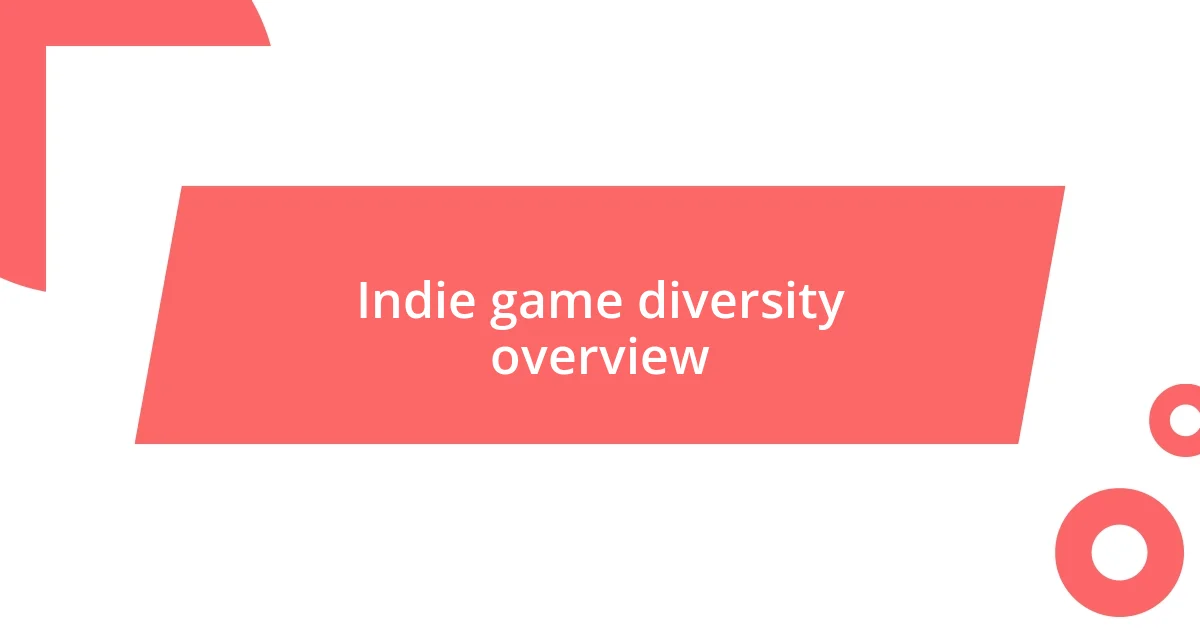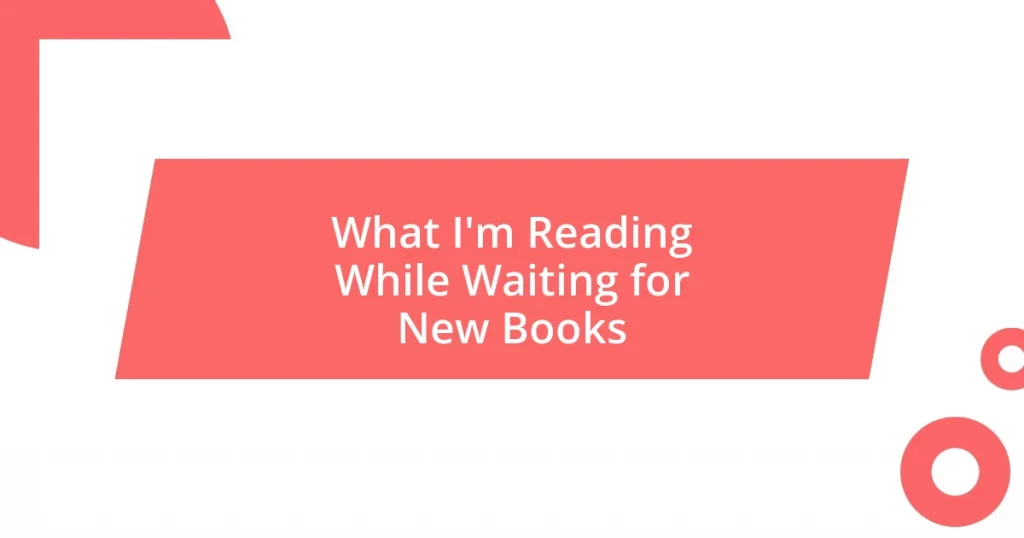Key takeaways:
- Indie games offer diverse narratives that address serious topics, enhancing empathy and understanding among players.
- Representation in game development is crucial for creating relatable characters and enriching storytelling through various cultural perspectives.
- Supporting diverse games involves promoting indie titles, engaging with marginalized developers, and advocating for inclusive representation in gaming media.

Indie game diversity overview
Indie game diversity goes beyond just visual representation; it encompasses different narratives, genres, and gameplay mechanics. I remember when I first played “Celeste,” a game that beautifully intertwines mental health awareness with platforming challenges. It struck me how powerful it is to find personal stories from diverse creators—stories that resonate with different aspects of life.
When I reflect on titles like “Night in the Woods,” I feel a sense of connection with the characters and their experiences. This game tapped into themes of community and mental health in a way I hadn’t seen before in mainstream titles. Isn’t it refreshing to see games that explore serious topics while still being engaging and fun to play?
As I explore more indie games, I often wonder how they provide such a unique perspective on culture and identity. I vividly recall the first time I played “Hades,” where I was immersed in a rich narrative that drew from mythology unlike anything I’d seen. It’s this kind of innovative storytelling that showcases the incredible diversity indie games bring to the table, making them a vital part of the gaming landscape.

Importance of diverse narratives
Diverse narratives in indie games offer fresh perspectives that challenge conventional storytelling. I still remember feeling a wave of emotion while playing “Spiritfarer,” a game that grapples with loss and the journey of helping spirits find peace. It really struck me how impactful it is when a game addresses such profound experiences, allowing players to reflect on their own journeys of grief and connection.
When I think about the variety of stories available in indie games, my mind goes to titles like “Life Is Strange.” The game’s ability to weave in themes of friendship, sexuality, and choices felt both relatable and empowering. It’s amazing how these stories open doors for conversations about topics that are often marginalized in mainstream media. Isn’t it inspiring to see such representation that makes players feel seen and understood?
The importance of diverse narratives also lies in their capacity to foster empathy. I was completely absorbed by “A Short Hike,” which encapsulated the joy of adventure while subtly exploring themes of self-discovery and community. This game reminded me of the importance of taking a step back in life and appreciating the quieter moments. Each of these unique experiences adds richness to the gaming world, encouraging players to embrace different viewpoints.
| Aspect | Diverse Narratives |
|---|---|
| Impact on Players | Encourages empathy and understanding |
| Representation | Reflects real-world diversity in themes |
| Storytelling Approaches | Innovative and thought-provoking |

Representation in game development
Representation in game development is crucial for portraying the rich tapestry of human experiences. I remember feeling a spark of excitement when I discovered “Disco Elysium,” a game that delved into different identities and social issues through its narrative. It was a revelation to see a game embrace complex themes, such as politics and mental health, allowing players to navigate dilemmas that felt deeply relatable. This kind of representation empowers developers to create characters that mirror the vast diversity of real-life experiences, ultimately making games more meaningful.
- Diverse development teams contribute to a wider range of perspectives.
- Authentic character representations foster connection with players.
- Inclusion of various art styles and cultural elements enhances storytelling.
In my experience, when a game takes the time to represent different voices, it not only enriches the gameplay but also creates a sense of community among players. I reflect on my time with “A Monster’s Eyes,” which features a protagonist discovering her family’s heritage as a game mechanic. It made me think about my own cultural background and how personal stories can shape our gaming experiences. This leads me to believe that the industry needs to champion diverse voices to ensure everyone feels seen in the digital worlds they explore.

Challenges for diverse game creators
Creating indie games can be a thrilling experience, but diverse creators often face significant hurdles. One challenge I’ve noticed is the lack of funding and resources available to underrepresented voices in the industry. I recall a conversation I had with a first-time game developer who poured their heart into a project inspired by their cultural heritage, only to find it difficult to secure the necessary backing. This scenario is all too common and can hinder the emergence of innovative narratives that deserve to be told.
Another obstacle revolves around bias within the gaming community. There’s a tendency to favor familiar tropes and styles, making it hard for experimental games to gain traction. I remember reading a review of a fascinating indie title that featured a queer protagonist navigating a unique world—yet the critic dismissed it as too “out there.” Why is it that creativity is sometimes met with skepticism instead of appreciation? This gatekeeping not only limits exposure for diverse creators but also stifles the richness of the gaming landscape.
Lastly, networking and support systems can be less accessible for those outside the mainstream. I once attended a gaming convention where I found it challenging to connect with industry veterans who were open to discussing diverse projects. It struck me how vital mentorship is in forging paths for new creators. We need to ask ourselves: how can we better support diversity in game development? By fostering inclusive communities and amplifying various voices, we can help break down these barriers and bring fresh, vibrant stories to life.

Success stories in indie games
Success stories in indie games showcase how passion and creativity can reshape the industry. One stand-out example is “Celeste.” I still remember the first time I played it; the way the game tackled mental health issues intertwined with platforming mechanics was both challenging and enlightening. It’s incredible to think about how it started with just a small team, yet it resonated with so many players, demonstrating that profound storytelling doesn’t always require a massive budget.
Another notable success is “Hades,” which breathes fresh life into the roguelike genre. The supergiant team built an engaging experience around Greek mythology that was not only visually stunning but also emotionally gripping. I often find myself reflecting on how the characters evolve with every run, making me feel like my choices mattered. This connection elevates the gaming experience, emphasizing that indie games can indeed compete with AAA titles when it comes to story and character development.
Lastly, consider “Stardew Valley,” a testament to the power of one passionate developer’s vision. I can’t help but smile when I reminisce about my hours spent farming and building relationships in that charming world. The game stands as a shining example of how a single individual’s dedication can lead to a global phenomenon, giving players the chance to escape into a cozy, pixelated paradise. It makes one wonder: if diverse voices are given the chance to shine, what other extraordinary stories are waiting to be told?

Future trends in game diversity
As we look ahead to the future of game diversity, I can’t help but feel optimistic about the emerging trends. There’s a growing recognition of the need for inclusive narratives. I’ve witnessed numerous indie game showcases highlighting works from creators across the globe—each offering a unique perspective. This shift not only enriches the storytelling landscape but also invites players to experience worlds they may never have encountered otherwise.
One exciting trend is the rise in cross-cultural collaborations. I recently came across a project where developers from different backgrounds pooled their skills to create a game steeped in multiple cultural elements. This fusion of ideas made for an incredibly vibrant and engaging experience, showcasing how collaboration can lead to richer narratives. It’s there that I ask: how can we encourage even more of these partnerships in indie gaming?
Additionally, I see a surge in the creation of games that challenge societal norms and foster discussions around critical topics like identity and mental health. For instance, I played a game recently that tackled the complexities of family dynamics within a cultural framework, and I was deeply moved. It made me reflect on my own background—demonstrating that when developers explore personal and often uncomfortable themes, they create space for empathy and understanding. This, I believe, is exactly the kind of evolution our gaming landscape desperately needs.

Ways to support diverse games
Supporting diverse games requires a multifaceted approach that players, developers, and the industry can collectively embrace. For one, I believe that actively seeking out and promoting indie games that feature diverse narratives is crucial. When I discovered a game centered around Indigenous storytelling, it not only broadened my understanding but also ignited a passion to share it with friends. Have you ever encountered a game that completely shifted your perspective? Those experiences are vital for fostering empathy and connection.
Another way we can bolster diversity in gaming is by engaging directly with marginalized developers. Attending events like PAX or IndieCade has allowed me to witness firsthand the incredible talent and creativity that often gets overlooked. I recall a small booth where a game creator passionately shared their journey. Their excitement was infectious, compelling me to dive into their game right then and there. Supporting such creators through funding, sharing their stories, or simply spreading the word can make a meaningful difference.
Lastly, advocating for diverse representation in gaming media and critiques is essential. I often find myself frustrated when reviews miss nuance in games that tackle complex issues, such as gender identity or cultural heritage. When I wrote about an indie game that explored LGBTQIA+ themes, it sparked conversations among my peers. It made me realize that when we advocate for critical dialogue around these games, we’re not just elevating diverse voices—we’re enriching our entire gaming culture. What other conversations could we start by advocating for these unique perspectives?















